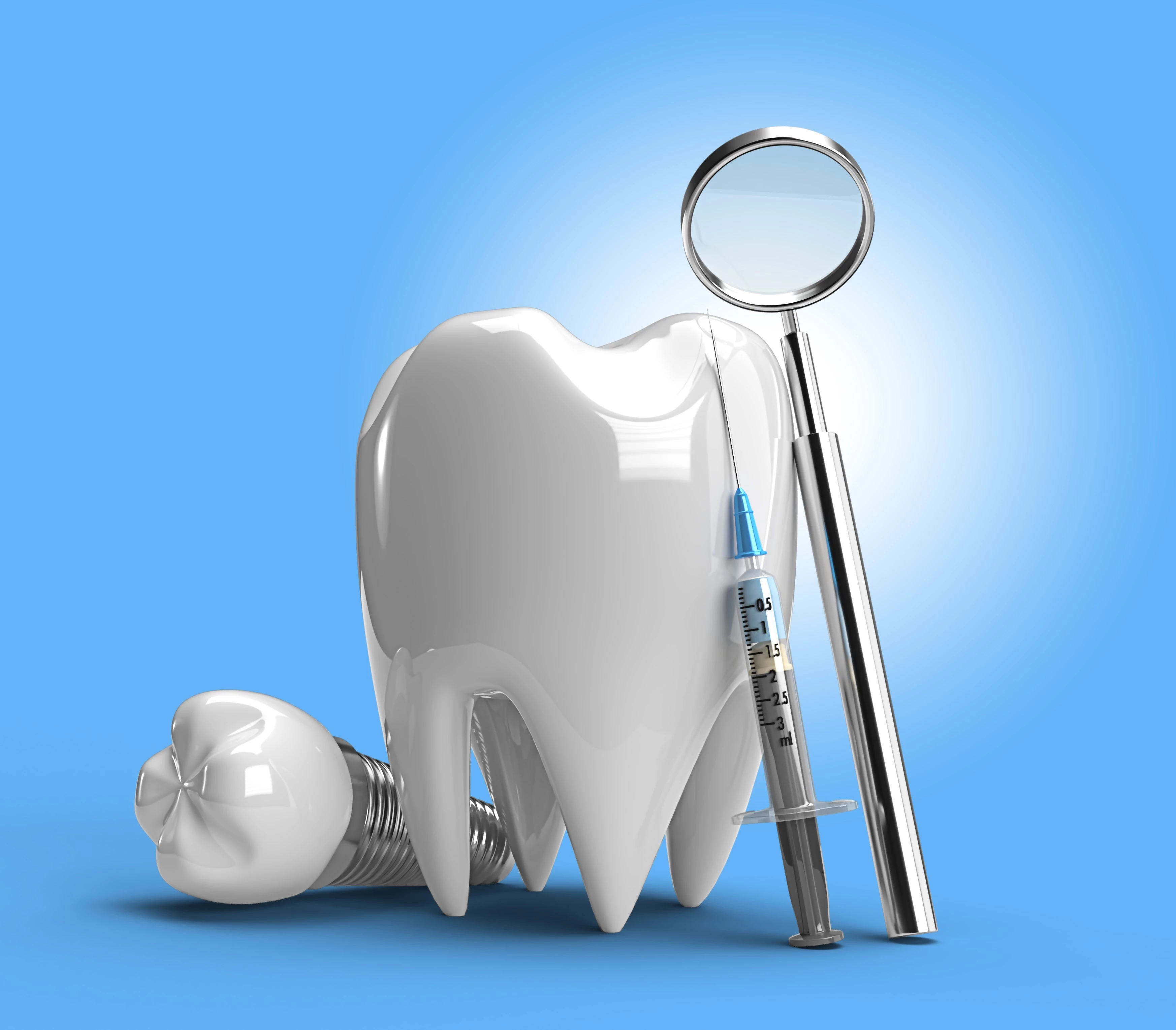Dental Implant procedure is a surgical process aimed at replacing missing teeth with well-anchored artificial teeth in the jaw. The procedure involves inserting permanent artificial roots. The dental implant procedure requires time to heal and allow the artificial teeth to properly focus on and integrate with the jawbone.

Dental Implant surgery is a modern surgical procedure used to replace missing teeth. This procedure is a good alternative to artificial bridges or traditional bridges, and is considered a permanent solution to gaps caused by missing teeth. It also supports the jaws and helps eliminate structural and functional problems resulting from tooth loss.
The requirements for undergoing a Dental Implant surgery vary depending on the patient's health condition, but typically include the following:
- The patient must be in good health and not have any health problems that may affect the healing process after the surgery.
- The patient must have enough bone in the jaw to support the implant.
- The gums must be healthy and free of inflammation and disease.
- The patient must be of a certain age, which varies depending on the treating dentist's determination.
- The patient must stop smoking and drinking alcohol before the surgery.
- The patient must be mentally prepared to undergo the surgical procedure.
Tooth implantation is routinely performed in dental clinics and consists of the following stages:
Firstly, the appropriate site for implantation is prepared by placing titanium alloy screws in the jawbone in the location of the missing tooth.
Secondly, the fusion of the jawbone and the screw, known as osseointegration, takes place. This process takes at least 3 months.
Thirdly, the final restoration of the implant involves several sessions to create the final structure from mouth impressions and to test it for final fixation.
Tooth implantation can be carried out without pain or with very mild and normal pain, which can be overcome with regular painkillers.
The implant can last a lifetime, but it depends on the patient's commitment to their dental health and their ability to maintain good oral hygiene.
The duration of Dental Implantation stages varies depending on the case, and is based on the type, location, size, and overall health of the individual. However, the basic stages of dental implantation include the following:
- Initial assessment: At this stage, it is determined whether dental implantation is the optimal solution for achieving the desired result.
- Preparation: In this stage, preparatory procedures such as tests, X-rays, and comprehensive planning of the operation are performed.
- Surgical operation: Here, the artificial root, called the implant, is implanted and installed in the bone in the position of the original tooth.
- Wound healing: Wound healing depends on the type and possibility of tissue renewal and can take anywhere from 6 weeks to 6 months.
- Integration: After the wound has healed, the dental support is installed and the artificial tooth is integrated onto it.
In general, dental implantation stages can take approximately 3 to 6 months, depending on the initial assessment and the individual's health condition.
Mild to moderate pain after surgery can usually be managed with prescription pain medications provided by the dentist, and the duration of pain after surgery depends on several factors, including:
- The size of the surgery: If the procedure is simple, the pain is likely to be mild and short-lived, while a larger and more complicated surgery may result in longer-lasting pain.
- Individual pain sensitivity: Everyone has a different tolerance for pain, and this can affect the duration of pain after surgery.
- Following post-operative care instructions: It is important for the patient to follow the dentist's instructions after surgery, such as avoiding hard foods and chewing on the surgical site, continuing to take prescribed medications, and getting plenty of rest. Failure to follow these instructions properly may affect the duration of pain.
The All-On-4 technique is a modern method used in Dental Implant surgery that involves the placement of four dental implants in either the upper or lower jaw to support and stabilize a fixed bridge that replaces all missing teeth. This technique offers several advantages:
- Quick treatment: Patients who have lost all of their teeth can receive a fixed bridge and teeth replacement within one day of the implant surgery.
- Avoidance of bone grafting: The All-On-4 technique maximizes the use of available jaw bone, making it suitable for patients who have limited bone mass in the jaw.
- Reduced number of implants: This technique reduces the number of implants required, which can decrease the cost of treatment. Patients only need four implants instead of the multiple implants required with traditional methods, which may be as many as 10 or more.
- Comfort and stability: The fixed bridge distributes pressure evenly on the implants and keeps them stable, providing patient comfort and enabling them to enjoy hard and tough foods.
- Quality and durability: The All-On-4 technique is one of the most high-quality and durable options for tooth replacement, with studies showing success rates as high as 98% over long periods of time.
The All-On-5 technique is a modern approach to Dental Implant surgery that is similar to the All-On-4 technique, but differs in the number of implants used. In the All-On-5 technique, five dental implants are placed in either the upper or lower jaw, instead of four in the All-On-4 technique. The All-On-5 technique offers the following advantages:
- Additional support: The All-On-5 technique provides additional support to the fixed bridge attached to the dental implants, helping to distribute pressure evenly and improve stability.
- Safety: The All-On-5 technique offers additional safety as an extra implant is placed, making the treatment more secure in case one of the implants fails.
- Functional performance: The All-On-5 technique helps improve the functional performance of the mouth, allowing patients to eat hard and chewy foods normally.
- Durability: The All-On-5 technique provides high durability and stability to the implants, allowing them to last longer and produce results similar to the All-On-4 technique.
There are several differences between Dental Implantation in the upper and lower jaw, including:
- Angle: Dental implants in the upper jaw are placed at a steeper angle compared to the lower jaw, making insertion more difficult and requiring higher experimental techniques.
- Location: The position of the maxillary sinuses differs between the upper and lower jaws, affecting the length and angle of the bone around the sinus and the level of the gums.
- Adjacent teeth: The upper jaw has a hole in the maxillary sinuses and contains air cells and other internal structures, unlike the lower jaw, which does not have similar structural issues, making the implantation process easier and smoother in the lower jaw.
- Function: The desired function must be considered when implanting teeth in both jaws. The upper jaw plays a greater role in speech and pronunciation, while the lower jaw controls jaw movement and biting.
In general, both upper and lower jaw implantations require different knowledge and experience from a specialized dentist to ensure the success of the procedure and achieve the best results.
The following instructions should be followed before a Dental Implant procedure:
- Dietary measures: Avoid eating or drinking anything for at least 6 hours before the procedure.
- Dietary measures: Avoid eating or drinking anything for at least 6 hours before the procedure.
- Smoking: Stop smoking for at least 24 hours before the procedure, as smoking delays the healing process.
- Medications: Take prescribed medications, such as anti-inflammatory drugs, painkillers, and antibiotics, about an hour before the procedure.
- Oral hygiene: Brush teeth and gums thoroughly and use mouthwash before the procedure.
- Anesthesia: Determine the appropriate type of anesthesia with the dentist before the procedure, whether it is general anesthesia or local anesthesia.
- Appointments: Confirm the scheduled appointment for the procedure and avoid canceling or rescheduling the procedure unless there is a medical reason to do so.
- Rest: Get enough rest before the procedure and avoid stress and anxiety, as they negatively affect the procedure and recovery process after the procedure.
After a Dental Implant surgery, the following instructions should be followed to promote healing and avoid complications:
- Dietary precautions: Solid or soft, hot or cold foods should be avoided for at least 24 hours after the surgery, and normal eating can be resumed after that.
- Bleeding: Mild bleeding may occur after the surgery, and the affected area should be pressed with ice powder or a clean cloth for 10-15 minutes to stop the bleeding.
- Pain: The patient may experience some pain after the surgery, and the prescribed painkillers can be used to alleviate it.
- Oral hygiene: The implanted area should not be brushed or cleaned for at least 24 hours, and after that, a toothbrush can be used gently.
- Smoking: Smoking should be avoided for at least 24 hours after the surgery, as it delays the healing process.
- Antibiotics: The prescribed antibiotics should be taken according to the specified doses.
- Appointments: Follow-up appointments with the dentist should be attended to monitor the healing process and ensure that there are no complications.
- Rest: Adequate rest should be obtained, and stress and anxiety should be avoided after the surgery, as they negatively affect the healing process.

